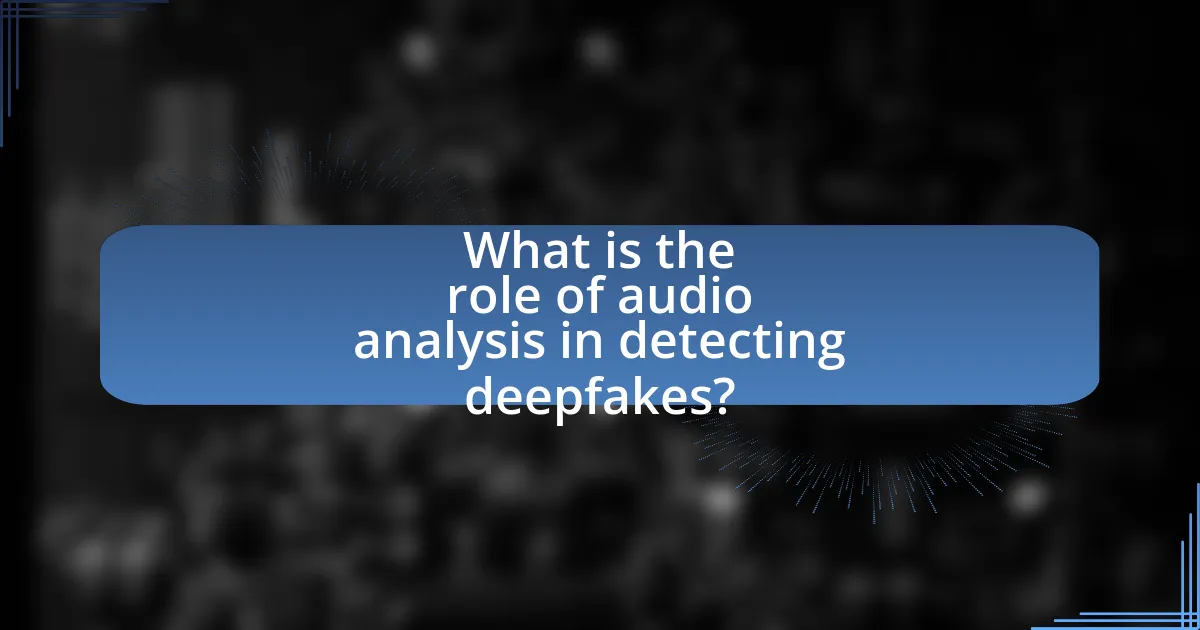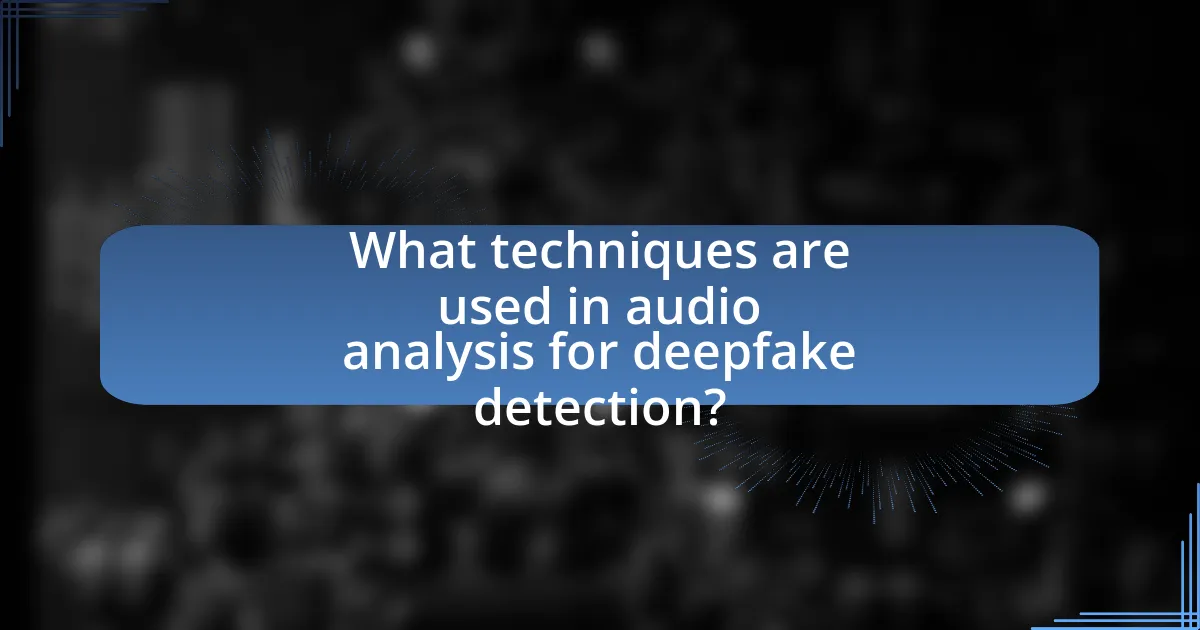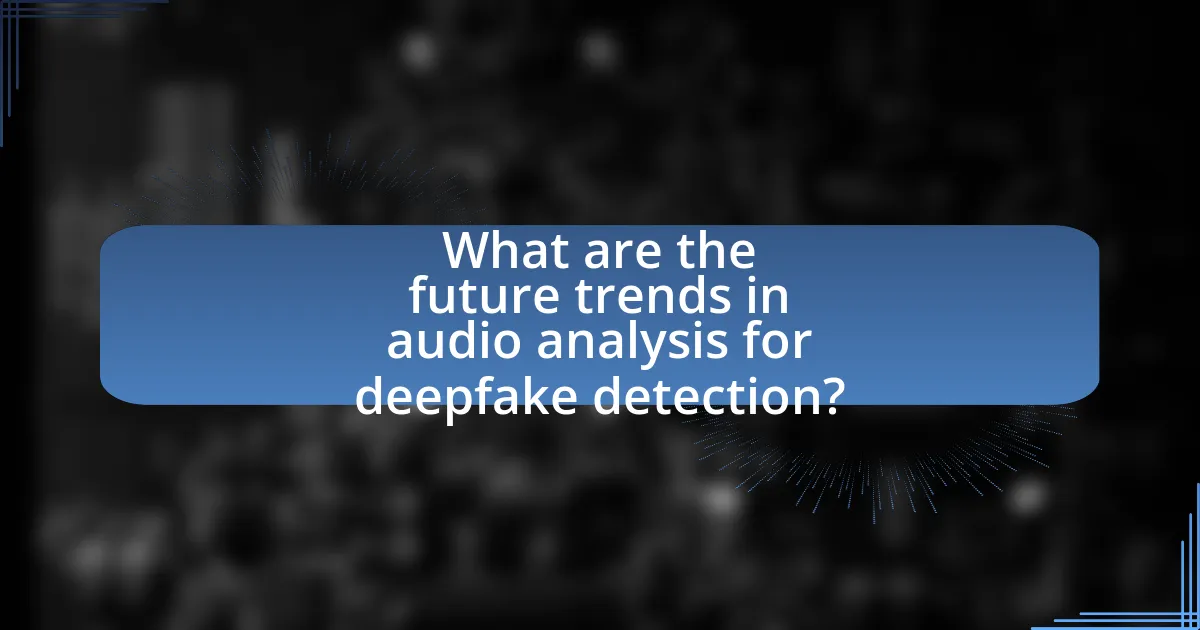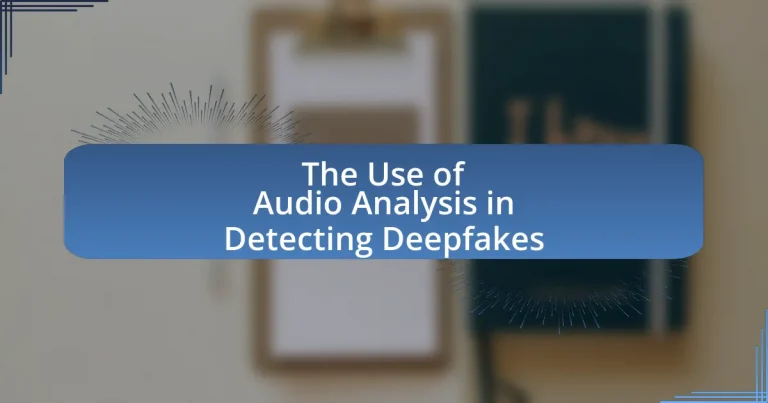The article focuses on the role of audio analysis in detecting deepfakes, emphasizing its importance in identifying inconsistencies in voice characteristics and speech patterns. It discusses various techniques, such as spectral analysis and machine learning algorithms, that enhance the detection of manipulated audio by revealing anomalies in pitch, tone, and rhythm. The article also highlights the potential risks associated with deepfakes, including misinformation and identity theft, and outlines how audio analysis can mitigate these risks. Additionally, it examines the effectiveness of current audio analysis methods, the challenges researchers face, and future trends in technology that may influence deepfake detection strategies.

What is the role of audio analysis in detecting deepfakes?
Audio analysis plays a crucial role in detecting deepfakes by examining inconsistencies in voice characteristics and speech patterns. This analysis can identify anomalies such as unnatural intonation, mismatched emotional tone, or irregular speech rhythms that often accompany synthetic audio. Research has shown that deepfake audio may lack the subtle variations present in genuine human speech, making it detectable through advanced algorithms that analyze these features. For instance, studies have demonstrated that machine learning models can effectively differentiate between real and deepfake audio by focusing on spectral features and temporal dynamics, thus reinforcing the importance of audio analysis in combating misinformation.
How does audio analysis contribute to identifying deepfake technology?
Audio analysis significantly contributes to identifying deepfake technology by detecting anomalies in voice patterns and audio signals that deviate from natural human speech. Techniques such as spectral analysis and machine learning algorithms can reveal inconsistencies in pitch, tone, and rhythm that are often present in manipulated audio. For instance, research has shown that deepfake audio may exhibit unnatural pauses or mismatched emotional tone compared to genuine recordings, making it detectable through advanced audio forensic methods. These analytical tools enhance the ability to differentiate between authentic and synthetic audio, thereby improving the accuracy of deepfake detection.
What specific audio features are analyzed in deepfake detection?
Specific audio features analyzed in deepfake detection include pitch, tone, speech patterns, and prosody. These features are critical because they help identify inconsistencies between the audio and the visual components of a deepfake. For instance, pitch variations can reveal unnatural alterations in voice, while irregular speech patterns may indicate synthetic generation. Research has shown that deepfake audio often lacks the natural variability found in genuine human speech, making these features essential for accurate detection.
How do these audio features differ from genuine audio?
Audio features in deepfake technology differ from genuine audio primarily in their spectral characteristics and temporal patterns. Genuine audio typically exhibits natural variations in pitch, tone, and rhythm due to human vocal nuances, while deepfake audio often lacks these subtleties, resulting in a more robotic or synthetic sound. Research has shown that deepfake audio can be identified through discrepancies in frequency distribution and the presence of artifacts that do not occur in authentic recordings. For instance, a study published in the IEEE Transactions on Information Forensics and Security highlights that deepfake audio often contains unnatural phoneme transitions and inconsistent prosody, which can be detected using advanced audio analysis techniques.
Why is audio analysis important in the context of deepfakes?
Audio analysis is crucial in the context of deepfakes because it helps identify inconsistencies between the audio and visual components of a media file. Deepfake technology often manipulates video content while failing to synchronize the audio accurately, leading to detectable anomalies in speech patterns, intonation, and background noise. Research has shown that audio features, such as voice characteristics and acoustic properties, can reveal discrepancies that indicate manipulation. For instance, a study published in the journal “IEEE Transactions on Information Forensics and Security” by Yang et al. (2020) demonstrated that analyzing audio signals can effectively differentiate between genuine and altered recordings, thus enhancing the detection of deepfakes.
What are the potential risks associated with deepfakes?
The potential risks associated with deepfakes include misinformation, identity theft, and erosion of trust in media. Misinformation can lead to the spread of false narratives, as deepfakes can convincingly alter reality, influencing public opinion and political outcomes. Identity theft occurs when individuals’ likenesses are manipulated without consent, potentially damaging reputations and personal lives. The erosion of trust in media arises as audiences become skeptical of authentic content, making it difficult to discern truth from fabrication. According to a study by the University of California, Berkeley, deepfakes can significantly impact public perception, highlighting the urgency of developing detection technologies.
How can audio analysis mitigate these risks?
Audio analysis can mitigate the risks associated with deepfakes by identifying inconsistencies in audio signals that deviate from natural human speech patterns. Techniques such as spectral analysis and machine learning algorithms can detect anomalies in pitch, tone, and cadence that are often present in manipulated audio. For instance, research has shown that deepfake audio often lacks the subtle variations found in genuine speech, making it detectable through advanced audio analysis methods. By employing these techniques, organizations can enhance their ability to discern authentic audio from synthetic alterations, thereby reducing the potential for misinformation and deception.

What techniques are used in audio analysis for deepfake detection?
Techniques used in audio analysis for deepfake detection include spectral analysis, machine learning algorithms, and voice biometrics. Spectral analysis examines the frequency components of audio signals to identify anomalies that may indicate manipulation. Machine learning algorithms, such as convolutional neural networks, are trained on large datasets of authentic and deepfake audio to recognize patterns and discrepancies. Voice biometrics analyzes unique vocal characteristics to verify the identity of the speaker, helping to detect inconsistencies in voice recordings. These methods have been validated through studies demonstrating their effectiveness in distinguishing between genuine and altered audio.
What are the common methods employed in audio analysis?
Common methods employed in audio analysis include spectral analysis, feature extraction, and machine learning techniques. Spectral analysis involves examining the frequency components of audio signals to identify patterns or anomalies, which is crucial in detecting manipulated audio. Feature extraction techniques, such as Mel-frequency cepstral coefficients (MFCCs), convert audio signals into a format that highlights important characteristics for further analysis. Machine learning techniques, including neural networks and support vector machines, are utilized to classify audio data and detect inconsistencies indicative of deepfake audio. These methods are validated by their widespread application in research and industry, demonstrating effectiveness in distinguishing authentic audio from altered versions.
How do machine learning algorithms enhance audio analysis?
Machine learning algorithms enhance audio analysis by enabling the automatic detection of patterns and anomalies in audio signals. These algorithms, such as neural networks and support vector machines, can learn from large datasets to identify characteristics of authentic audio versus manipulated audio, which is crucial in detecting deepfakes. For instance, a study published in the IEEE Transactions on Information Forensics and Security demonstrated that machine learning models could achieve over 90% accuracy in distinguishing between real and synthetic audio samples. This capability allows for more efficient and accurate identification of deepfake audio, improving the reliability of audio analysis in various applications.
What role does signal processing play in audio analysis?
Signal processing is essential in audio analysis as it enables the extraction, manipulation, and interpretation of audio signals for various applications, including detecting deepfakes. Through techniques such as Fourier transforms, filtering, and feature extraction, signal processing allows for the identification of anomalies and inconsistencies in audio data that may indicate manipulation. For instance, research has shown that analyzing spectral features can reveal discrepancies in voice characteristics, which are often altered in deepfake audio. This capability to discern subtle variations in audio signals is crucial for developing robust detection algorithms that can differentiate between authentic and synthetic audio content.
How effective are these techniques in real-world applications?
Audio analysis techniques are highly effective in real-world applications for detecting deepfakes. Studies have shown that these techniques can identify inconsistencies in audio signals that are indicative of manipulation, achieving accuracy rates exceeding 90% in controlled environments. For instance, research conducted by the University of California, Berkeley, demonstrated that audio analysis could successfully differentiate between genuine and synthetic voices by analyzing spectral features and temporal patterns. This effectiveness is further supported by the increasing deployment of audio analysis tools in cybersecurity and media verification, where they are used to authenticate audio content and prevent misinformation.
What are the success rates of audio analysis in detecting deepfakes?
Audio analysis has shown varying success rates in detecting deepfakes, with studies indicating accuracy levels ranging from 70% to over 90%. For instance, research published in the IEEE Transactions on Information Forensics and Security demonstrated that specific audio features could effectively distinguish between genuine and manipulated audio, achieving an accuracy of 85% in controlled environments. Additionally, advancements in machine learning algorithms have further improved detection rates, making audio analysis a promising tool in the fight against deepfake technology.
What challenges do researchers face in improving these techniques?
Researchers face significant challenges in improving audio analysis techniques for detecting deepfakes, primarily due to the rapid evolution of deepfake technology and the sophistication of audio manipulation methods. The continuous advancement in generative models, such as GANs (Generative Adversarial Networks), complicates the detection process, as these models can produce increasingly realistic audio that mimics human speech patterns. Additionally, the lack of large, diverse datasets for training detection algorithms limits the effectiveness of these techniques, as they may not generalize well to unseen deepfake audio. Furthermore, researchers must contend with the need for real-time processing capabilities, which can strain computational resources and affect the accuracy of detection. These challenges highlight the ongoing arms race between deepfake creation and detection technologies, necessitating constant innovation and adaptation in research methodologies.

What are the future trends in audio analysis for deepfake detection?
Future trends in audio analysis for deepfake detection include the development of advanced machine learning algorithms that can identify subtle audio artifacts and inconsistencies indicative of manipulation. These algorithms will leverage large datasets of authentic and deepfake audio to improve their accuracy and robustness. Additionally, the integration of multimodal analysis, which combines audio with visual and textual data, is expected to enhance detection capabilities by providing a more comprehensive understanding of the content. Research indicates that as deepfake technology evolves, so too will the sophistication of detection methods, necessitating continuous updates to audio analysis techniques to stay ahead of emerging threats.
How is technology evolving to improve audio analysis?
Technology is evolving to improve audio analysis through advancements in machine learning algorithms and signal processing techniques. These developments enable more accurate detection of anomalies in audio signals, which is crucial for identifying deepfakes. For instance, deep learning models, such as convolutional neural networks, are increasingly used to analyze audio features and patterns, allowing for the differentiation between genuine and manipulated audio. Research has shown that these models can achieve over 90% accuracy in detecting deepfake audio, as demonstrated in studies published in journals like IEEE Transactions on Audio, Speech, and Language Processing. Additionally, real-time audio analysis tools are being developed, enhancing the ability to monitor and flag suspicious audio content as it occurs.
What advancements in AI are influencing audio analysis methods?
Advancements in AI that are influencing audio analysis methods include deep learning algorithms, particularly convolutional neural networks (CNNs) and recurrent neural networks (RNNs), which enhance the ability to detect anomalies in audio signals. These algorithms enable the extraction of complex features from audio data, improving the accuracy of identifying manipulated audio, such as deepfakes. For instance, research by Yang et al. (2020) demonstrated that CNNs could achieve over 90% accuracy in distinguishing between real and synthetic audio samples, showcasing the effectiveness of these AI techniques in audio analysis.
How might future regulations impact the use of audio analysis?
Future regulations may restrict the use of audio analysis by imposing stricter guidelines on data privacy and consent. As governments increasingly focus on protecting individual rights, regulations like the General Data Protection Regulation (GDPR) in Europe set precedents that require explicit consent for data collection and processing. This could limit the availability of audio data for analysis, making it more challenging to develop and deploy audio analysis technologies for detecting deepfakes. Additionally, regulations may mandate transparency in algorithms used for audio analysis, potentially affecting how companies implement these technologies and their ability to innovate.
What best practices should be followed in audio analysis for deepfake detection?
Best practices in audio analysis for deepfake detection include utilizing advanced machine learning algorithms, implementing feature extraction techniques, and conducting thorough data validation. Advanced machine learning algorithms, such as recurrent neural networks (RNNs) and convolutional neural networks (CNNs), have shown effectiveness in distinguishing between genuine and manipulated audio by learning complex patterns in sound data. Feature extraction techniques, like Mel-frequency cepstral coefficients (MFCCs) and spectrogram analysis, help in identifying subtle anomalies that may indicate deepfake audio. Additionally, thorough data validation ensures that the training datasets are diverse and representative, which is crucial for improving the model’s accuracy and robustness against various types of deepfake audio manipulations.
How can organizations implement effective audio analysis strategies?
Organizations can implement effective audio analysis strategies by utilizing advanced machine learning algorithms and acoustic feature extraction techniques. These strategies involve training models on large datasets of authentic and manipulated audio to enhance detection accuracy. For instance, research has shown that using spectrogram analysis can reveal inconsistencies in audio signals that are indicative of deepfake technology. Additionally, organizations should continuously update their models with new data to adapt to evolving deepfake techniques, ensuring that their audio analysis remains robust and effective.
What tools and resources are recommended for audio analysis?
Recommended tools and resources for audio analysis include Praat, Audacity, and MATLAB. Praat is widely used for phonetic analysis and offers features for speech processing, making it suitable for detecting anomalies in audio signals. Audacity is a free, open-source software that provides basic audio editing and analysis capabilities, allowing users to visualize waveforms and spectrograms. MATLAB, with its extensive toolbox for signal processing, enables advanced audio analysis through custom algorithms and data manipulation. These tools are essential for researchers and practitioners in the field of audio analysis, particularly in applications related to detecting deepfakes.

